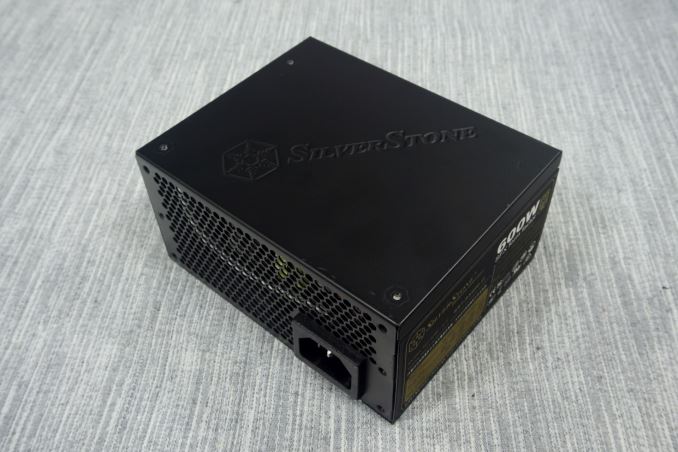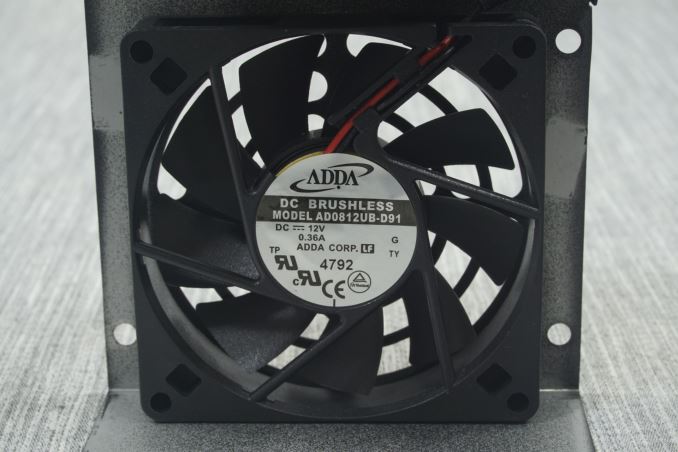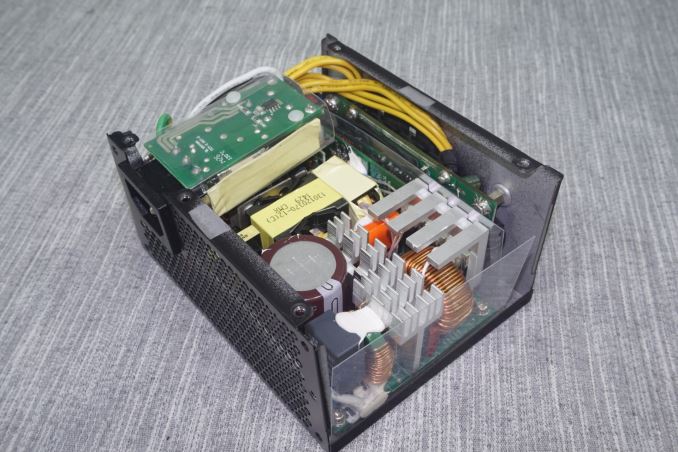The SilverStone SX600-G SFX PSU Review
by E. Fylladitakis on August 21, 2015 8:00 AM EST- Posted in
- PSUs
- Cases/Cooling/PSUs
- 80Plus Gold
- SilverStone
- SFX
- 600W
- Enhance
External Appearance
The SilverStone SX600-G SFX obviously is very small compared to an ATX PSU, measuring in at the SFX standard dimensions of just 125 × 63.5 × 100 mm (W×H×D). Due to the limited internal volume the SFX form factor affords, most SFX PSUs come with a 60mm fan, so imagine our surprise at finding an 80mm fan in the SX600-G. Having a larger cooling fan fit into the SFX form factor and on top of that managing to fit large enough components to reach an output of 600 Watts with 80Plus Gold efficiency levels seems like quite an engineering feat. Meanwhile the small body is sprayed with a satin black paint that is fingerprint resistant.
SilverStone made the odd move to punch their company logo at the top side and place the sticker with the electrical specifications and certifications on the left side of the chassis. It is likely that the company expects the top of the PSU to be more frequently visible than its side, but such aesthetic improvements are of questionable value on such products, as SFF and desktop cases rarely have windowed panels anyway.
Meanwhile there is nothing of importance at the rear side of the unit, not even an on/off switch. Apparently, every bit of space does matter and even a switch would not easily fit inside such a densely packed design. The few connectors for the modular cables can be seen at the front of the PSU.
Internal Design
The thin 80 mm fan of the SX600-G SFX PSU is supplied by ADDA, one of the most renowned fan manufacturers. The AD0812UB-D91 is a very high speed model, capable of reaching a maximum speed of 4800 RPM at 12V input. And although that sounds like a scary number compared to the speeds of 120/140 mm fans found in larger PSUs, it is not dramatic for an 80 mm fan. As with the vast majority of such high speed models, it has a ball bearing.
The OEM behind the very densely packed design you see below is Enhance. Enhance is not a very common manufacturer for high output PSUs, but they do specialize on SFX/SFF and proprietary PSU designs. It is so densely packed that it is very difficult to make head or tails of what components are being used without at least partially dismantling it. There is a PCB attached to the back of the AC receptacle with half of the filtering stage components on it, while the other half is on the main PCB. There are a total of four Y capacitors, two X capacitors and two filtering inductors. For safety, there is also a metal oxide varistor and a simple glass fuse for limited surge protection.
Due to space restrictions, Enhance had to keep things relatively simple. The SX600-G is based on a simple half-bridge active rectification design, with two MOSFETs feeding the main transformer. The rectifiers at the secondary of the main transformer generate only a 12V line and the minor 3.3V/5V lines are converted from it using DC-to-DC conversion circuits. By replacing passive components (diodes) with active components (transistors) and using DC-to-DC circuits for the minor voltage lines, Enhance improved the efficiency of the SX600-G without having to use "exotic" technologies or much more expensive parts.
The primary APFC capacitor is a high quality product supplied by Nippon Chemi-Con (450V/330μF), but there is complete chaos at the other side of the transformer, with the rest of the capacitors coming from no less than six different brands. We saw electrolytics from Elite, Teapo, Rubycon, SunCon and Su'Scon, while the polymer capacitors are supplied by Gemmy Electronics and G-Luxon. It appears as if half of Asia came together to build this PSU. The assembly quality is rather good, considering the very small proportions and density of the unit.






















20 Comments
View All Comments
duyfken - Friday, August 21, 2015 - link
Any chance of reviews on the Corsair SF600 (competing 600W SFX and 92mm fan in the SFX form factor with High Power as OEM) or Silverstone SX500-LG (500W Extended SFX form factor with 120mm fan and again the OEM is High Power)?E.Fyll - Saturday, August 22, 2015 - link
It is very likely, yes. One thing at the time.Corsair's model is not available yet.
duyfken - Saturday, August 22, 2015 - link
Cheers, good news for more informed decisions on (many) future iTX builds :)tonyou - Sunday, August 23, 2015 - link
High Power is not the OEM for SF600 (it was in fact Great Wall) according to Corsair's own personnel:http://www.jonnyguru.com/forums/showthread.php?t=1...
StrangerGuy - Saturday, August 22, 2015 - link
I wish SFX is the new mainstream standard for PSUs. The sheer size of ATX PSUs is wastingso much physical space inside a mITX/mATX enclosure, and the vast majority of users simply doesn't need more than 400W even for a gaming PC with power requirements dropping like a rock since 2011.Or even better, a complete move to a +12V DC PSU standard to cut down even more PSU circuitry and save more space at the same time.
sor - Saturday, August 22, 2015 - link
Most power supplies are more efficient at higher voltage, not less. It would be interesting to see you retest at 120vDanNeely - Saturday, August 22, 2015 - link
He can't. He lives in a country with 220V wall power; which means the only way to get 120V is a huge transformer.sor - Saturday, August 22, 2015 - link
Only because it's a quickie review. It wasn't that long ago that I remember seeing PSU reviews here where they were opening them up and critiquing the internals and choices of components, looking at electrical noise of the switching IC, rectifier, and MOSFETs, etc. I think Anandtech could arrange to test a PSU at both common voltages/frequencies if they wanted to make a good quality review. A desktop variac can probably be picked up for the price of this PSU or less and could be used for many reviews. Or perhaps they employ someone stateside who could run a few tests on the same model.I get that this is just a drive-by review for the weekend that isn't intended to be a thorough or high budget affair. And I don't really even know if they're the type who just ships free stuff from manufacturers to your house to try out or if they have invested a couple of hundred into various lab equipment on regular occasion to do proper testing, but I feel like review sites used to lean toward the latter and we are losing that slowly in favor of review mills.
At any rate, the only reason any of this came up is because the reviewer mentioned that it didn't meet 80 plus. That seems like an interesting thing to dig into, because one familiar with power supplies would expect the situation to get worse at 120v.
E.Fyll - Monday, August 24, 2015 - link
Actually, that is entirely wrong. I do have a VARIAC and I do use it to get an exact 230 VAC output. However, dropping the voltage down to 110/120 Volts is just false/fake testing. You see, VARIACs convert the voltage output but do nothing about the frequency. Whoever is claiming to be using a VARIAC for dual voltage testing, sorry, that's just wrong.To perform testing at any voltage/frequency, you need a programmable power source. One in the range of 2-3 KVA costs about $25.000. I do not think that I need to explain why I do not have one.
home improve - Tuesday, August 25, 2015 - link
Depending on the games an individual plays, it is advisable to a high-end graphics card for several reasons such as stereoscopic 3D...<a href="http://www.myhomeimprovementsolutions.com/best-gam... games</a>